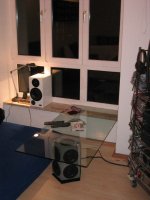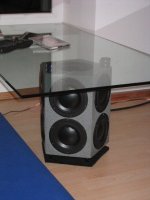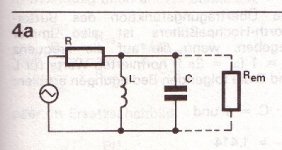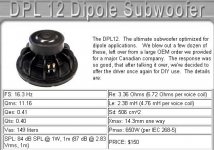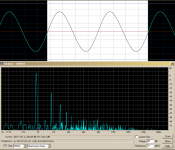Some days ago I stated that I had no Audio projects since 10 years.
I simply had forgotten my subwoofer !!!
About 5 years ago I designed a funny small sub woofer, which is
still satisfying my ears.....
Only around 12 litres (netto), but impressive 15Hz and a linear volume displacement of around 600ccm (max. 1400ccm !).
I will put some more details about the construction in my next posting.
I simply had forgotten my subwoofer !!!
About 5 years ago I designed a funny small sub woofer, which is
still satisfying my ears.....
Only around 12 litres (netto), but impressive 15Hz and a linear volume displacement of around 600ccm (max. 1400ccm !).
I will put some more details about the construction in my next posting.
Attachments
What happens if we design a closed box and simply make it to small?
The resonance frequency will be high, the damping poor.
First let's have a look to the resonance frequency. Closed cabins give
a nice high pass filter with 2nd order (please don't try this approach with vented designs!!!).
In an active solution you can easily compensate this by giving more gain to the lower frequencies
with a 2nd order characteristic reverse to the box.
I used standard OP amps for this (N5534A: yes old, but OK.....).
The box has 11 small Dynaudio Woofers (ESOTEC 15W-75) and volume of
around 12litres. This results in a resonance frequency of about 155Hz.
The pentagon shape avoids undesired resonances.
I used this type of speaker because they have 75mm coils, which makes them rugged enough
in thermal and the driving force is given to the membran well distributed.
Of course one drawback: The required power at low frequencies is getting high, very high.
Let's estimate for 30Hz, here this tiny box is already giving 28db less than nominal.
The proper compensation will give 625 times more power to the speaker.
WOW! OK, I really tried this concept in an excessive way.
Currently I am using a traditional analog amp, which can deliver around 1.5kW
to the 11 parallel speakers.
For long term power I put a limiter. When running the box at 100W continuosly
for 3 hours, the coils temperature stabilizes at 80°C. The entire box is warm.
In fact the speakers still have some margin, but going to limit would only bring around
2db more average output.....
Please note that in normal music the ratio of short term power and long term
average is around 10:1...20:1 in this frequency range. So the 1.5kW amp matches
quite good with the 100W average limit.
Damping: Here we have a direct influence of the resistance in the electrical circuit.
normaly this is dominated by the speaker. The output impedance of the amp + wiring typically
is 50....200 less than the speakers impedance.
Well, let's give a negative output-impedance to the amp!!!!!
With this we can adjust the damping to any value we need.
For low frequencies this is easy ( for high frequencies up to now not a good idea......).
You simply need to measure the output current and feed it back positive.
Please note. The negative output impedance must be less than the speakers impedance,
otherwise the system ist getting instable!
In the last 3 years several new and especially for sub woofer applications designed speakers
came to the market. So this posting here may encourage you to do your own experiments.
My personal feeling is that a less excessive design might be more fortunate with respect to
the required power. Setting up your own design will require some good fundamental know how about
speakers, filters, feedback control and amplifiers.... Not the right thing for newcomers.
Of course I can give some more detailed hints, if you really want to set up a subwoofer with this
concept.
Have fun
Markus
P.S. Is there anybody who has done something similar? Which experiences did you make?
The resonance frequency will be high, the damping poor.
First let's have a look to the resonance frequency. Closed cabins give
a nice high pass filter with 2nd order (please don't try this approach with vented designs!!!).
In an active solution you can easily compensate this by giving more gain to the lower frequencies
with a 2nd order characteristic reverse to the box.
I used standard OP amps for this (N5534A: yes old, but OK.....).
The box has 11 small Dynaudio Woofers (ESOTEC 15W-75) and volume of
around 12litres. This results in a resonance frequency of about 155Hz.
The pentagon shape avoids undesired resonances.
I used this type of speaker because they have 75mm coils, which makes them rugged enough
in thermal and the driving force is given to the membran well distributed.
Of course one drawback: The required power at low frequencies is getting high, very high.
Let's estimate for 30Hz, here this tiny box is already giving 28db less than nominal.
The proper compensation will give 625 times more power to the speaker.
WOW! OK, I really tried this concept in an excessive way.
Currently I am using a traditional analog amp, which can deliver around 1.5kW
to the 11 parallel speakers.
For long term power I put a limiter. When running the box at 100W continuosly
for 3 hours, the coils temperature stabilizes at 80°C. The entire box is warm.
In fact the speakers still have some margin, but going to limit would only bring around
2db more average output.....
Please note that in normal music the ratio of short term power and long term
average is around 10:1...20:1 in this frequency range. So the 1.5kW amp matches
quite good with the 100W average limit.
Damping: Here we have a direct influence of the resistance in the electrical circuit.
normaly this is dominated by the speaker. The output impedance of the amp + wiring typically
is 50....200 less than the speakers impedance.
Well, let's give a negative output-impedance to the amp!!!!!
With this we can adjust the damping to any value we need.
For low frequencies this is easy ( for high frequencies up to now not a good idea......).
You simply need to measure the output current and feed it back positive.
Please note. The negative output impedance must be less than the speakers impedance,
otherwise the system ist getting instable!
In the last 3 years several new and especially for sub woofer applications designed speakers
came to the market. So this posting here may encourage you to do your own experiments.
My personal feeling is that a less excessive design might be more fortunate with respect to
the required power. Setting up your own design will require some good fundamental know how about
speakers, filters, feedback control and amplifiers.... Not the right thing for newcomers.
Of course I can give some more detailed hints, if you really want to set up a subwoofer with this
concept.
Have fun
Markus
P.S. Is there anybody who has done something similar? Which experiences did you make?
Attachments
I love big bass, and small boxes. I also love Dynaudio.(Thats why I have them in my car) but what I shy away from is really high cost, and 11(!) ESOTECS?
Its a beutiful project, and very impressive results. Its just a bit too much out of my range of knowlage to even begin to make suggestions, or comments.
Its a beutiful project, and very impressive results. Its just a bit too much out of my range of knowlage to even begin to make suggestions, or comments.
Konnichiwa,
Well, things of that sort are quite common in Germany, where this principle is called URPS (Under Resosance Principle Subwoofer). I still have also one of these on the drawing board, using a simple square pillar and 8 Drivers. The ones that caught my eye are the beautifully made 8" unit from Apex Jr.
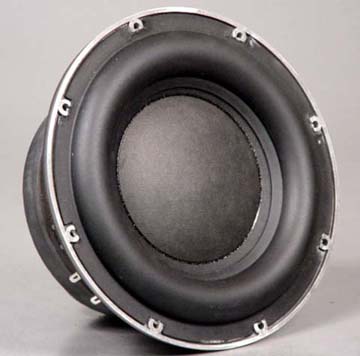
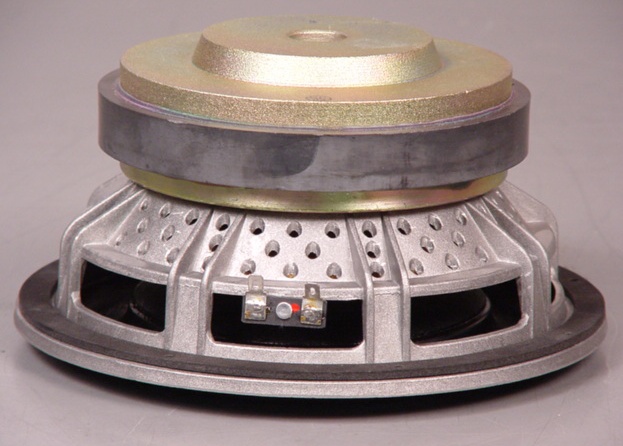
These cost $ 70 in pairs, so 8pcs will set you back $ 280. The Volume dispacement should be similar to that quoted above, around 600cm^3++.
The Column looks like it would have to be probably around 12" X 12" X 18" made in 1" MDF. This gives 25 liter volume gross, probably around 16 Liter once the drivers static displacement is accounted for. This gives around 2 liter volume per driver and thus as single driver in halve space produces 90db/2.83V/1m @ 100Hz with a resonance at around 150Hz. At 50Hz the SPL is down 14db and at 25Hz it is down 28db.
Using a sensible 150W RMS power limit per driver we would like an Amplifier with 1K2W output Power, into 8 Ohm if we wire the drivers series/parallel. Alternatively 4pcs LM3886 could be employed Bridge/parallel per driver with around +/-25..30V supplies to keep the dissipation per chip lowish. Probably better to bridge one of the Big Tripath Modules for nearly 2KW power.
If we drive 8 Drivers series parallel with 2.83V in total we get 68db/2.83V @ 25Hz, 82db/2.83V @ 50Hz and 99db/2.83V @ 100Hz. With 1K2W (or 31dbW) we can have theoretically 99db/1m @ 25Hz. Placing the sub into a corner will boost the LF level by another 4 - 5db, so I think a pair of subwoofers would make a good figure for larger rooms.
The material cost would likely be < $ 1,500 for a pair of these and probably < $ 750 for a single unit, with an output capability in line with some very "high end" Subwoofers in an increadibly compact format.
Sayonara
JCoffey said:I love big bass, and small boxes. I also love Dynaudio.(Thats why I have them in my car) but what I shy away from is really high cost, and 11(!) ESOTECS?
Its a beutiful project, and very impressive results. Its just a bit too much out of my range of knowlage to even begin to make suggestions, or comments.
Well, things of that sort are quite common in Germany, where this principle is called URPS (Under Resosance Principle Subwoofer). I still have also one of these on the drawing board, using a simple square pillar and 8 Drivers. The ones that caught my eye are the beautifully made 8" unit from Apex Jr.


These cost $ 70 in pairs, so 8pcs will set you back $ 280. The Volume dispacement should be similar to that quoted above, around 600cm^3++.
The Column looks like it would have to be probably around 12" X 12" X 18" made in 1" MDF. This gives 25 liter volume gross, probably around 16 Liter once the drivers static displacement is accounted for. This gives around 2 liter volume per driver and thus as single driver in halve space produces 90db/2.83V/1m @ 100Hz with a resonance at around 150Hz. At 50Hz the SPL is down 14db and at 25Hz it is down 28db.
Using a sensible 150W RMS power limit per driver we would like an Amplifier with 1K2W output Power, into 8 Ohm if we wire the drivers series/parallel. Alternatively 4pcs LM3886 could be employed Bridge/parallel per driver with around +/-25..30V supplies to keep the dissipation per chip lowish. Probably better to bridge one of the Big Tripath Modules for nearly 2KW power.
If we drive 8 Drivers series parallel with 2.83V in total we get 68db/2.83V @ 25Hz, 82db/2.83V @ 50Hz and 99db/2.83V @ 100Hz. With 1K2W (or 31dbW) we can have theoretically 99db/1m @ 25Hz. Placing the sub into a corner will boost the LF level by another 4 - 5db, so I think a pair of subwoofers would make a good figure for larger rooms.
The material cost would likely be < $ 1,500 for a pair of these and probably < $ 750 for a single unit, with an output capability in line with some very "high end" Subwoofers in an increadibly compact format.
Sayonara
...yes the costs were somehow inconvinient...
But 5 years ago I did not find any dedicated URPS-drivers. At this time I also looked at Apex, but
did not get what I was looking for...
About 3 years ago suddenly subwoofers with interresting drivers were coming from every
end... I think I was simply looking some years to early.
Now I feel several suitable drivers are available and also switchmode amps are more common,
this is why I encouraged this thread.
Kuei's project looks really interesting. And this drivers will for sure enable him to get even better
results than my old design. Much more volume displacement per box volume.
The Apex drivers look impressive (... will have a look to their Web-Site..)
And this at reasonable price. Yeah, cool!
But do you really want to place it in a corner? My personal trial always ended up
in a position with some distance to all wall and corners. Otherwise I got booming
resonaces of the room... OK, more pressure, but much less pleasure to my ears.
I could think now to set up a new subwoofer, too.
...with some more updated speakers and a switch mode amp...
and then I could use my nice small ESOTECs for new satelite speakers....
hm....
Unfortunately such a project would take me 5 years... Cannnot spend time every day
for this hobby :-(( !!
JC, well even a DIYer does not need to do every component on his own.
You can buy such systems, too. Unfortunately the real good systems seem to
be quite expensive...
But 5 years ago I did not find any dedicated URPS-drivers. At this time I also looked at Apex, but
did not get what I was looking for...
About 3 years ago suddenly subwoofers with interresting drivers were coming from every
end... I think I was simply looking some years to early.
Now I feel several suitable drivers are available and also switchmode amps are more common,
this is why I encouraged this thread.
Kuei's project looks really interesting. And this drivers will for sure enable him to get even better
results than my old design. Much more volume displacement per box volume.
The Apex drivers look impressive (... will have a look to their Web-Site..)
And this at reasonable price. Yeah, cool!
But do you really want to place it in a corner? My personal trial always ended up
in a position with some distance to all wall and corners. Otherwise I got booming
resonaces of the room... OK, more pressure, but much less pleasure to my ears.
I could think now to set up a new subwoofer, too.
...with some more updated speakers and a switch mode amp...
and then I could use my nice small ESOTECs for new satelite speakers....
hm....
Unfortunately such a project would take me 5 years... Cannnot spend time every day
for this hobby :-(( !!
JC, well even a DIYer does not need to do every component on his own.
You can buy such systems, too. Unfortunately the real good systems seem to
be quite expensive...
I love big bass,and Large boxes
I notice
1) small woofer
2) attempting high spl
3) attempting low frequency
4) 28db EQ
These things are not associated with low distortion.
you dont mention xmax at all..
It does look nice.
Definately, you did!
To me changing the amplifier output impedence is just fun,i think you can reduce the damping factor slightly,but remember it will change the speaker Qts factor...mucking up your alignment
Personally- I would prefer a trusty 15" jbl to do the job,or basshorn.
Have you measured SPL and distortion?
i would like to know it
Cheers
Mike

I notice
1) small woofer
2) attempting high spl
3) attempting low frequency
4) 28db EQ
These things are not associated with low distortion.
you dont mention xmax at all..
It does look nice.
WOW! OK, I really tried this concept in an excessive way.
Definately, you did!
To me changing the amplifier output impedence is just fun,i think you can reduce the damping factor slightly,but remember it will change the speaker Qts factor...mucking up your alignment
Personally- I would prefer a trusty 15" jbl to do the job,or basshorn.
Have you measured SPL and distortion?
i would like to know it
Cheers
Mike
Hi Mikee!
In fact I cannot measure the distorsion and I agree on your concerns
regarding this point. I think the large voice coils of the Dynaudio speakers
are the best way to avoid that the bending of the speakers membranes.
This was the reason why I did not like most of the high excursion speakers
five years ago. They were typically running 2" voice coils for a 12" speaker....
Well, my ears say that the resulting distorsions of the speakers are OK.
But I had to struggle with the distorsions of the amplifier!!!
As the box defeat about 28 dB at 30Hz (I coupled the system below 40Hz)
which is the desired signal to hear, but do not defeat at the frequencies of most amplifiers distorsions.
This system requires a real low distorsion amp.
I had not expected this and had to redesign the amp... and now it is fine.
X-max of the small ESOTECs is 15mm (peak-peak). Linear about half of it.
So the 600ccm are peak-peak. Sufficient for normal levels in typical living rooms, but not for disco.
Also at the limit for real home theatre.
But I estiamte the limit of my neighbours around 200ccm anyway..... ;-)
In fact I also love the big JBL drivers, but without electronic correction they also will not make a flat frequency response down to 15Hz....
But the real worse thing is that I would have to place it in the hyper space and beam its sound to my small appartment....
Unfortunately- up to know I did not manage to design such a system ;-)
In fact I cannot measure the distorsion and I agree on your concerns
regarding this point. I think the large voice coils of the Dynaudio speakers
are the best way to avoid that the bending of the speakers membranes.
This was the reason why I did not like most of the high excursion speakers
five years ago. They were typically running 2" voice coils for a 12" speaker....
Well, my ears say that the resulting distorsions of the speakers are OK.
But I had to struggle with the distorsions of the amplifier!!!
As the box defeat about 28 dB at 30Hz (I coupled the system below 40Hz)
which is the desired signal to hear, but do not defeat at the frequencies of most amplifiers distorsions.
This system requires a real low distorsion amp.
I had not expected this and had to redesign the amp... and now it is fine.
X-max of the small ESOTECs is 15mm (peak-peak). Linear about half of it.
So the 600ccm are peak-peak. Sufficient for normal levels in typical living rooms, but not for disco.
Also at the limit for real home theatre.
But I estiamte the limit of my neighbours around 200ccm anyway..... ;-)
In fact I also love the big JBL drivers, but without electronic correction they also will not make a flat frequency response down to 15Hz....
But the real worse thing is that I would have to place it in the hyper space and beam its sound to my small appartment....
Unfortunately- up to know I did not manage to design such a system ;-)
Just one more point.
You influence the damping of the system very much by the impedance of the amplifier, not only marginal.
If we look to the simplified equivalent schematic of a speaker (attached),
we can see an LC-R-circuitry.
L and C reflect the resonance system of the speaker( dominated by moving mass and the spring). Rem reflects the mechanical dampig, which is typically weak compared to the damping of the eletromagneitc loop. R is reflecting the DC-resistance of the speaker.
The electromagnetic loop is electrically closed through the signal generator/amp.
The internal resistance is positioned in series to the Rdc of the speaker.
By changing the internal resistance of the amp to negative values you can definitely influence the damping in a dramatic way!
Of course this is changing the complete set up of the box. Yes, but on purpose.
Optimised adjustement will also depend on the room and the position of the box. Different situations require different damping of the system.
In fact proper placing a subwoofer is much more difficult than normally promoted....
You influence the damping of the system very much by the impedance of the amplifier, not only marginal.
If we look to the simplified equivalent schematic of a speaker (attached),
we can see an LC-R-circuitry.
L and C reflect the resonance system of the speaker( dominated by moving mass and the spring). Rem reflects the mechanical dampig, which is typically weak compared to the damping of the eletromagneitc loop. R is reflecting the DC-resistance of the speaker.
The electromagnetic loop is electrically closed through the signal generator/amp.
The internal resistance is positioned in series to the Rdc of the speaker.
By changing the internal resistance of the amp to negative values you can definitely influence the damping in a dramatic way!
Of course this is changing the complete set up of the box. Yes, but on purpose.
Optimised adjustement will also depend on the room and the position of the box. Different situations require different damping of the system.
In fact proper placing a subwoofer is much more difficult than normally promoted....
Attachments
I know that YAMAHA AST cancels out the speakers Rdc with this method.
quote from a loudspeaker book(forgot the name)
' this results in higher than usual port output'
for 16hz=
http://www.adireaudio.com/diy_audio/drivers/adire/dpl12.htm


quote from a loudspeaker book(forgot the name)
' this results in higher than usual port output'
for 16hz=
http://www.adireaudio.com/diy_audio/drivers/adire/dpl12.htm
Attachments
That driver looks almast exactly the same as the Eminence LAB12 driver. I have four LAB12's in my shop, and I plan on putting two of them in a 1 ft^3 box and doing a linkwitz transform to it. This box will be driven by one side of a crown MA2400. I should be able to get an f3 of around 15-18 Hz. Any comments?
Cheers,
Zach
Cheers,
Zach
I have four LAB12's in my shop, and I plan on putting two of them in a 1 ft^3 box and doing a linkwitz transform to it. This box will be driven by one side of a crown MA2400. I should be able to get an f3 of around 15-18 Hz. Any comments?
if you enjoy
1) high distortion
2) low output
3) inefficient operation
Then build it
Model it in winisd pro from www.linearteam.dk
get the winisd patch,which will make it 0.7,use LT filter,and see excursion for yourself
It isnt my cup of tea
I just treid a shiva in 20litres. runs out of excursion with 32watts with an LT
Cheers!
@mikee
.."running out of excursion" sounds like you tried it with a vented box, which is the default setting. They typically run that way if driven below their tuning frequency.
It tried my 11 Dynaudio 15W-75 in a closed 12l box. I recommend this URPS principle for closed cabinets only.
The program states results that match really good with my measurements.
Fres: 159Hz , my measurement 158Hz
Qtc: 1,144, my measurement 1,12
max. power for linear operation at 30 Hz: 702W
My measurement 780W (Well, excursion during operation is not easy to measure.....)
Thanks for the link to the "linear people"!
The program seems to give quite reasonable results.
@usekgb:
...doing a linkwitz transform to it.....
If you are not using the system in the area of the resonance frequency,
then the filter type (linkwitz or butteworth or tschebycheff or else) is
not so important, because at a certain margin from the roll off (at least one octave) they all give the same steepness.
But if run the system also in the area of the resonance frequency, then the filter
characteristic must match to your box. I do not think that two Eminence LAB 12
in a 11l box will give a linkwitz characteristic.....
2 speakers with an Vas of 125l ==> together 250l...
....pressing them into a 1 ft^3 (around 11l ??) closed cabinet..
Damn that's excessive!
You may end up in a resonance frequency somewhere around 110Hz.
But with speakers which would naturally have 22Hz!
You plan 2 speakers with 8Ohms, parallel.. ending up at 4Ohms?
One chanel of the crown, 800W?
Probably underpowered for what such a consruction would need.
For 13mm excursion 30Hz you would probably needmore than 10kW.
(Excursion is a square root function of power)
On the other side I have doubts that this speaker with large diaphragma,
but small voice coil whould not show heavy bending of the diaphragma itself.
And the voice coils would probably also not be able to handle the really required
power for full diaphragma excursion. In this ultra small cabins the required power at low frequencies
is very high, while excursion is relatively small.....so the self ventilation is poor compared to
the applied power!
I am not convinced that this design would be succesful.
Also please be aware if your filter does not really compensate the low frequency defeat of the closed cabinet, then it will sound like a telephone...
The Dynaudio ESOTECs have a diameter of 145mm (less than 6") and a voice coil of 75mm (about 3").....
.."running out of excursion" sounds like you tried it with a vented box, which is the default setting. They typically run that way if driven below their tuning frequency.
It tried my 11 Dynaudio 15W-75 in a closed 12l box. I recommend this URPS principle for closed cabinets only.
The program states results that match really good with my measurements.
Fres: 159Hz , my measurement 158Hz
Qtc: 1,144, my measurement 1,12
max. power for linear operation at 30 Hz: 702W
My measurement 780W (Well, excursion during operation is not easy to measure.....)
Thanks for the link to the "linear people"!
The program seems to give quite reasonable results.
@usekgb:
...doing a linkwitz transform to it.....
If you are not using the system in the area of the resonance frequency,
then the filter type (linkwitz or butteworth or tschebycheff or else) is
not so important, because at a certain margin from the roll off (at least one octave) they all give the same steepness.
But if run the system also in the area of the resonance frequency, then the filter
characteristic must match to your box. I do not think that two Eminence LAB 12
in a 11l box will give a linkwitz characteristic.....
2 speakers with an Vas of 125l ==> together 250l...
....pressing them into a 1 ft^3 (around 11l ??) closed cabinet..
Damn that's excessive!
You may end up in a resonance frequency somewhere around 110Hz.
But with speakers which would naturally have 22Hz!
You plan 2 speakers with 8Ohms, parallel.. ending up at 4Ohms?
One chanel of the crown, 800W?
Probably underpowered for what such a consruction would need.
For 13mm excursion 30Hz you would probably needmore than 10kW.
(Excursion is a square root function of power)
On the other side I have doubts that this speaker with large diaphragma,
but small voice coil whould not show heavy bending of the diaphragma itself.
And the voice coils would probably also not be able to handle the really required
power for full diaphragma excursion. In this ultra small cabins the required power at low frequencies
is very high, while excursion is relatively small.....so the self ventilation is poor compared to
the applied power!
I am not convinced that this design would be succesful.
Also please be aware if your filter does not really compensate the low frequency defeat of the closed cabinet, then it will sound like a telephone...
The Dynaudio ESOTECs have a diameter of 145mm (less than 6") and a voice coil of 75mm (about 3").....
.."running out of excursion" sounds like you tried it with a vented box, which is the default setting
no,sealed box.
It just seems like 'what is the worst way to use a woofer?'
= LT!
it just doesnt agree with my ideas
Cheers
my horn at its RMS rating and 45hz....
Attachments
Hi Zach!
Uhhps I messed up when calculating 1ft^3 into litres.....
1ft^3 is around 25l...30, not 11l.....
OK, that is still very small, but some
chance that you will get it working.
But you will probably operate the system also at its resonance frequency. This requires for a good matching of the filter characteristics......
...difficult project!
Do you have some more details about
your filters for equalizing/compensating the low frequency attenuation of the box?
Cheers!
Markus
Uhhps I messed up when calculating 1ft^3 into litres.....
1ft^3 is around 25l...30, not 11l.....
OK, that is still very small, but some
chance that you will get it working.
But you will probably operate the system also at its resonance frequency. This requires for a good matching of the filter characteristics......
...difficult project!
Do you have some more details about
your filters for equalizing/compensating the low frequency attenuation of the box?
Cheers!
Markus
Hi Mikee!
..yes, this are different worlds!
In fact I like horns. They are very efficient. But horns for low frequencies are large.
The horn area must grow very slowly for this......
Also vented designs are more efficient than a closed cabinet. But you can only run them above their tuning frequency. Below that they will defeat by 4th or 6th order (sealed only 2nd order).
If you design vented cabinates for low frequencies you will also end up in a large design....
Well, since several years power amplifiers for low frequencies are no issue any more.
1kW...2kw... what ever you want!
But limited space in my appartment is an issue.....
That's the main reason for such URPS designs.
The price for small size is efficiency and distorsion. I agree.
But according my experience bass is suffering more from poor resonances of your room than from distorsion. And in this regard this design is very fortunate! You can adjust the damping and you have a small box which can be easily positioned an acustically reasonable place.
..yes, this are different worlds!
In fact I like horns. They are very efficient. But horns for low frequencies are large.
The horn area must grow very slowly for this......
Also vented designs are more efficient than a closed cabinet. But you can only run them above their tuning frequency. Below that they will defeat by 4th or 6th order (sealed only 2nd order).
If you design vented cabinates for low frequencies you will also end up in a large design....
Well, since several years power amplifiers for low frequencies are no issue any more.
1kW...2kw... what ever you want!
But limited space in my appartment is an issue.....
That's the main reason for such URPS designs.
The price for small size is efficiency and distorsion. I agree.
But according my experience bass is suffering more from poor resonances of your room than from distorsion. And in this regard this design is very fortunate! You can adjust the damping and you have a small box which can be easily positioned an acustically reasonable place.
ChocoHolic said:Hi Zach!
Uhhps I messed up when calculating 1ft^3 into litres.....
1ft^3 is around 25l...30, not 11l.....
OK, that is still very small, but some
chance that you will get it working.
But you will probably operate the system also at its resonance frequency. This requires for a good matching of the filter characteristics......
...difficult project!
Do you have some more details about
your filters for equalizing/compensating the low frequency attenuation of the box?
Cheers!
Markus
Basically, I'm just playing around with ideas I haven't tried before. I originally planned on doing this with one driver, but I don't think I will be able to get enough SPL out of just one. Thus.........Why not go overboard and put in two?
Now, using a larger box, I can really get some low end out of this system. Using a 2 ft^3 (56.6 liter) box, I get a 6db down point of 35 Hz and a Qtc of 0.88. If I put these numbers in to Linkwitz's tables, I get an f(p) of 15 Hz and a DC gain of 14.72. This is very doable without using an unreasonabley large enclosure.
As for horns, they are very efficient, but not my cup of tea. I think they are very useful when you need to project low frequencies over long distances, such as outdoor concerts, but they just don't seem to blossom without a large listening room.
I also use vented cabinets all the time. Unfortunately, a cabinet with two LAB12's requires about 7.5 ft^3! This is quite a bit bigger than I am able to put in my apartment.
The main reason I was thinking of the dual LAB12 in a sealed box was just to try something different and have some fun while doing it. As it is, 2 LAB12's in 3.5 ft^3 gives an f3 of about 40 Hz, which could easily be equalized to extend lower if desired. In fact, I am installing such a system this weekend at a local night club using 4 LAB12's, two per side. I am eager to see how it sounds.
Thanks for the input everybody. Please let me know if my reasoning is off somewhere, or if I am missing something obvious.
Cheers,
Zach
Interresting very interresting!!
Have you guys considered what to use for equalisation??
I'm building the Thor subwoofer on the Linkwitzlab site. I made a PCB for the EQ circuit. Not operational yet but i tried it with my multimeter and a sinus generator and I got the exact response that's on the site.
Now it remains to be seen if it applies when I put it to the test in my living room.
I will drive it with a bridged amp of the famous PA 300 from the elektor magazine, 600Watts that should do wouldn't you think??
I'm not at home at the moment so I can't do the modeling in any of the programs above.
Hell if it doesn't work out i'll just make the box smaller and put in a passive woofer and i'm set
but we'll just have to wait and see.
But I like your thoughts, thinking of the fact that companys like B&O, Sunfire and some other use the very same ideas.
So keep it up
Have you guys considered what to use for equalisation??
I'm building the Thor subwoofer on the Linkwitzlab site. I made a PCB for the EQ circuit. Not operational yet but i tried it with my multimeter and a sinus generator and I got the exact response that's on the site.
Now it remains to be seen if it applies when I put it to the test in my living room.
I will drive it with a bridged amp of the famous PA 300 from the elektor magazine, 600Watts that should do wouldn't you think??
I'm not at home at the moment so I can't do the modeling in any of the programs above.
Hell if it doesn't work out i'll just make the box smaller and put in a passive woofer and i'm set
but we'll just have to wait and see.
But I like your thoughts, thinking of the fact that companys like B&O, Sunfire and some other use the very same ideas.
So keep it up
600Watts that should do wouldn't you think??
if your EQing 20db....
to have the same SPL you need 20db more amplification available.
1
2
4
8
16
32
64
128 21db
256
512
you can input a few watts before using your 600watts rms and losing all your headroom..
[horns]but they just don't seem to blossom without a large listening room.
Mine does.
An externally hosted image should be here but it was not working when we last tested it.
Cheers
Linkwitz transform
The "Linkwitz transform" is a pole shifter and Q adjuster, not a standard highpass/lowpass filter.
http://linkwitzlab.com/filters.htm#9
...doing a linkwitz transform to it.....
If you are not using the system in the area of the resonance frequency,
then the filter type (linkwitz or butteworth or tschebycheff or else) is
not so important, because at a certain margin from the roll off (at least one octave) they all give the same steepness.
The "Linkwitz transform" is a pole shifter and Q adjuster, not a standard highpass/lowpass filter.
http://linkwitzlab.com/filters.htm#9
- Status
- This old topic is closed. If you want to reopen this topic, contact a moderator using the "Report Post" button.
- Home
- Loudspeakers
- Subwoofers
- Tiny 12 litre subwoofer making 15Hz and 600ccm?
